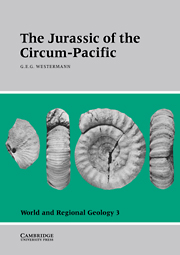Book contents
- Frontmatter
- Contents
- List of contributors
- Preface
- Acknowledgments
- Introduction
- Part I Time scales
- Part II Circum-Pacific base map
- Part III Regional geology and stratigraphy
- 4 Western Canada and United States
- 5 Meso-America
- 6 Western South America and Antarctica
- 7 Australasia
- 8 Indonesia and Papua New Guinea
- 9 Southeast Asia and Japan
- 10 Eastern China
- 11 Eastern Russia
- Part IV Biochronology
- Part V Biogeography
- Part VI Climatology and oceanography
- Appendix: Biochronology and atlas with index and guide fossils
- General Index
- Index of Guide- and Indexfossils
6 - Western South America and Antarctica
Published online by Cambridge University Press: 04 August 2010
- Frontmatter
- Contents
- List of contributors
- Preface
- Acknowledgments
- Introduction
- Part I Time scales
- Part II Circum-Pacific base map
- Part III Regional geology and stratigraphy
- 4 Western Canada and United States
- 5 Meso-America
- 6 Western South America and Antarctica
- 7 Australasia
- 8 Indonesia and Papua New Guinea
- 9 Southeast Asia and Japan
- 10 Eastern China
- 11 Eastern Russia
- Part IV Biochronology
- Part V Biogeography
- Part VI Climatology and oceanography
- Appendix: Biochronology and atlas with index and guide fossils
- General Index
- Index of Guide- and Indexfossils
Summary
REGIONAL SETTING
Morphostructural units
Most of eastern South America, between the Orinoco, the Atlantic Ocean, and the La Plata River, is formed by the Precambrian Brazilian and Guyanas Shields, consisting of several crustal domains (Cordani et al. 1988). To the west the Brazilian shield is flanked, from north to south, by the Llanos, Beni-Chaco, and Pampas plains (Figure 6.1).
In the west and south, smaller Precambrian to Lower Paleozoic tectonic units are present in southern Peru, central Argentina, and eastern Patagonia. The latter two areas form the nucleus of the Pampean, North Patagonian, and Deseado massifs, which behaved as positive stable blocks throughout the Phanerozoic.
Along the western margin of South America, from its southern tip to the Caribbean sea, the Andes are formed by several mountain ranges. These ranges are technically divided along strike into several segments (Gansser 1973; Sillitoe 1974; Barazangi and Isacks 1976; Hervé et al. 1988; Megard 1988). This division is probably related to variations in plate geometry along the subduction zone of the Nazca Plate underneath the South American Plate, caused by consumption of the Carnegie, Grijalba, Nazca, and Juan Fernandez aseismic ridges and the active Chile Rise (Nur and Ben-Abraham 1981; Ben-Abraham and Nur 1988). Although the Andean ranges are best developed in the Central Andes, we will proceed from the north to the south.
Northern Andes
The northern Andes extend from 5°S to the Caribbean coast.
- Type
- Chapter
- Information
- The Jurassic of the Circum-Pacific , pp. 122 - 161Publisher: Cambridge University PressPrint publication year: 1993
- 3
- Cited by



